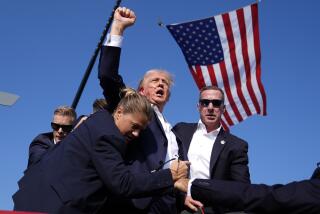Celebrating 100 years or more of T-shirts: All hail the white tee
- Share via
This year marks the 100th birthday of the T-shirt. Maybe.
It’s clear the simple little garment has been around for many, many years and rose in popularity just as fashion was losing some of its starch. But no one knows exactly when the T-shirt as we know it was born.
What we do know is that in 1913, the U.S. Navy brought tees into public consciousness in a big way when it ordered a “light undershirt” for sailors to wear beneath their uniforms.
Americans were likely taking their cue from European soldiers who had begun sporting lightweight cotton undergarments. But online T-shirt maker CustomInk, for one, has seized on the Navy’s 1913 endorsement of the garment to trumpet the T-shirt’s century mark, as well as round up its own list of iconic T-shirts through the ages.
Among them? A “Property of USC” T-shirt. From the Southern California point of view, the “real” T-shirt was born right here. Articles from the Los Angeles Times’ archives point to the year 1932, when legendary USC football coach Howard Jones and athletic director Bill Hunter asked Jockey International Inc. to create a sweat-absorbent undershirt that would keep shoulder pads from chafing players’ skin.
The shirts, stenciled with “Property of USC” to discourage theft, became wildly popular with students.
But T-shirts had entered the fashion lexicon years before that.
The first use of the word “T-shirt” in print was in 1920 in F. Scott Fitzgerald’s “This Side of Paradise,” according to fashion historian Heather Vaughan. Protagonist Amory Blaine is setting out for New England, “the land of schools,” and his list of supplies included “six suits summer underwear, six suits winter underwear, one sweater or T shirt.”
The T-shirt gained popularity in an era when the union suit fell by the wayside and underwear was becoming outerwear. What was it that brought what had essentially been an undergarment out into the sunshine?
Three things were key, Vaughan told the Los Angeles Times: Everyday wear was becoming more informal, sportswear was on the rise and men’s relationship with their undershirts was changing.
In the late 1920s, she said, the one-piece union suit was out, and sleeveless undershirts were in. Then Clark Gable took off his shirt in the movie “It Happened One Night” (1934) to reveal his bare chest. Legend has it there was a dip in undershirt sales, which may or may not be so. But as men debated skipping the undershirt like Gable, they were donning T-shirts for daywear.
It was part of the gradual change in fashion from the 1920s to the 1940s, said Vaughan, Western region president of the Costume Society of America.
“During this time, fashion became somewhat less formal,” she said, “and casualwear grew more distinct.”
French tennis player René Lacoste (le crocodile) popularized in the 1920s a lightweight cotton knit shirt with short sleeves and a rib knit collar -- the polo shirt. He moved to fashion design in 1933, Vaughan said, and men’s casual attire in that decade grew to include knit polo shirts, “with Henleys and T-shirts worn while playing sports.”
In 1938, Sears sold what it called a “gob”-style tee (slang for Navy seaman) for 24 cents each. The ad proclaimed: “It’s an undershirt. It’s an overshirt.” In ‘42, one of the earliest printed T-shirts -- Air Force Gunnery School, worn by a strapping student -- made the cover of Life magazine. During World War II, Army soldiers so liked their own T-shirts that they opted to wear them instead of the Army-issued tank-style undershirt, according to the 90th Infantry Division Preservation Group.
Graphic T-shirts got their real start around 1950 as the original licensee for Disney characters, Tropix Togs, adorned T-shirts with Mickey Mouse and a gun-toting Davy Crockett, among other characters.
Not long after, Hollywood reached a zenith of T-shirt hotness -- 1951 brought “A Streetcar Named Desire,” with Marlon Brando bellowing, “Hey, Stella!” in a ripped T-shirt that revealed his well-muscled back. Brando wore his tee under leather in 1953’s “The Wild One.” Then James Dean created a classic image in white tee and blue denim in 1955’s “Rebel Without a Cause.”
Tie-dyed T-shirts became a symbol of the 1960s, when message shirts also came into their own. Warren Dayton created wearable art with images of Cesar Chavez, the Statue of Liberty, “polluted lungs and other political and comic images,” as his website states. The ‘60s also saw the kickoff of “Che chic,” with T-shirts stamped with the face of Argentine Marxist revolutionary Che Guevara.
By comparison, memorable images from the 1970s and ‘80s were on the lighter side -- the Rolling Stones’ lips and tongue, the happy face icon, the MTV logo. This era also saw the advent of the iron-on transfer. It was instant customization, as CustomInk notes.
In honor of the T-shirt centennial, the online T-shirt maker’s top 100 iconic T-shirts include the Stussy and Big Dogs logos, “Frankie says Relax,” “Jesus is my homeboy,” “Vote for Pedro” (from the 2004 movie “Napoleon Dynamite”) and Milton Glaser’s 1977 design “I [heart] NY,” which the site calls “one of the most worn T-shirts of all time.”
The tee may have begun as an undergarment, but it became a fashion staple. The last century has seen the T-shirt transform into a personal billboard -- carrier of messages, conveyor of attitude and attempted humor. T-shirt designs and logos are now so ubiquitous as to be virtually unnoticeable.
Perhaps most startling, a century later, is that garment that started it all -- the plain white T-shirt.
ALSO:
Shinola recreates its brand, with watches
“Bacheolorette” beefcakes to wear Vilebrequin trunks
Is H&M collaboration the end of Isabel Marant’s reign of cool?







